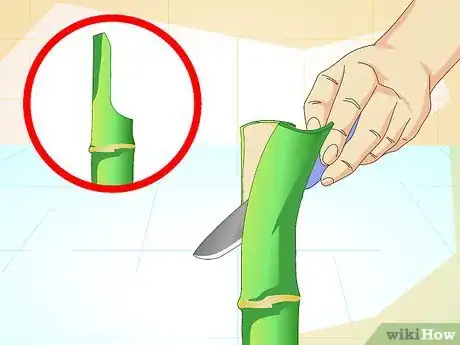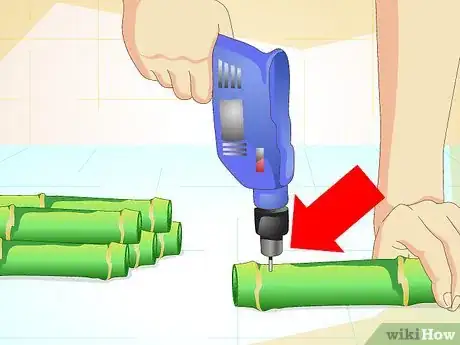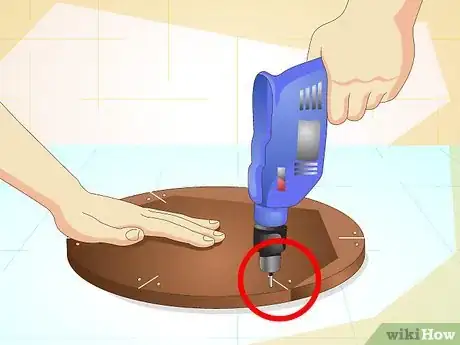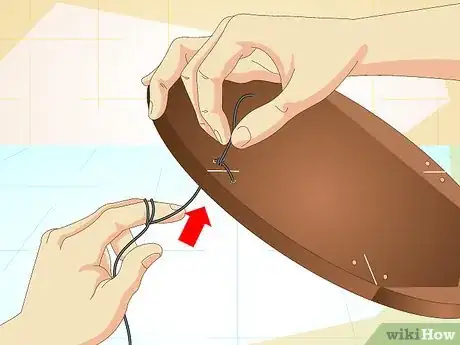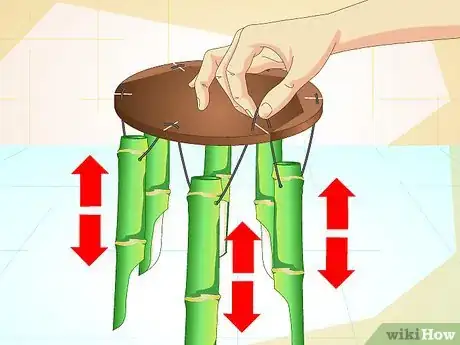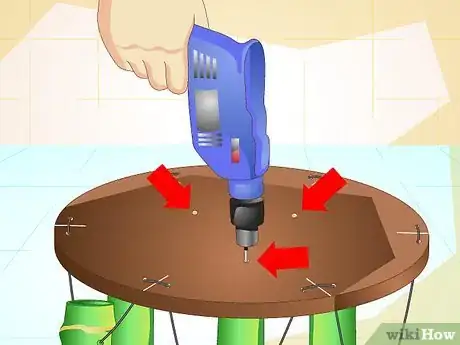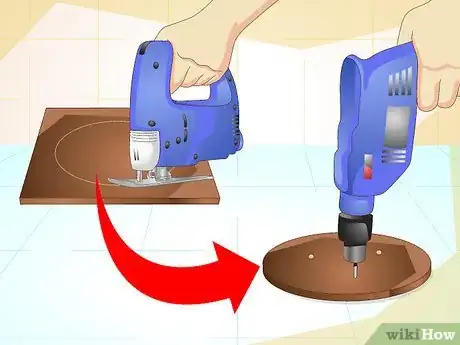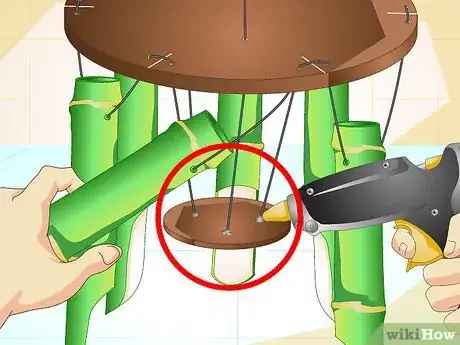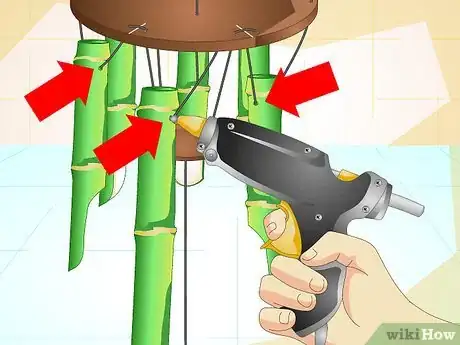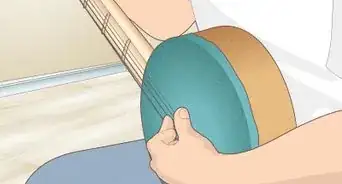wikiHow is a “wiki,” similar to Wikipedia, which means that many of our articles are co-written by multiple authors. To create this article, 26 people, some anonymous, worked to edit and improve it over time.
wikiHow marks an article as reader-approved once it receives enough positive feedback. This article received 11 testimonials and 94% of readers who voted found it helpful, earning it our reader-approved status.
This article has been viewed 376,042 times.
Learn more...
Wind chimes, a decorative piece that can liven up your home, can be made from a variety of materials such as ceramic pieces and metal tubing. If you are going for a natural look and mellow tone, bamboo is an excellent material to use. You can make a simple project out of creating your own bamboo wind chime by following the steps below.
Steps
Printable Wind Chime Template
Making a Bamboo Wind Chime
-
1Find some bamboo. If you are lucky, bamboo may already be growing wild in your area, and it is simply a matter of obtaining permission and cutting the bamboo plant to a proper size. If there is no local source, you may be able to purchase a common bamboo pole, used for fishing. You can also often buy bamboo poles of varying sizes at garden supply stores.
- Make sure your bamboo is thoroughly seasoned and is not split or rotten.[1]
-
2Cut the bamboo into six lengths. Each length should be composed of two of the plant's "sections", with one end above the partition-like segment end, and the other below it, so you have an open tube to work with.Advertisement
-
3Split the hollow end of each piece. This can be done with a very sharp knife, but care must be used, since both the splinters from the bamboo and the knife can impale or cut you. If you have a vice, it might be easier (and less risky) to fix the bamboo in the vice and cut it with a saw, especially if it is quite tough. Taper the last inch (2.5cm) or so off at an angle.[2]
-
4Drill 1/8 inch (3mm) holes just above the section on the solid end of each piece, parallel to the cut you made on the opposite end. This will ensure the hollow, concave bamboo "channel" will be facing out on each tube when they are assembled.[3]
-
5Cut a round piece of plywood or other material about 7 times the diameter of the average piece of bamboo. In the photos, each piece was about 1 inch in diameter, so the plywood disk is 7 inches (~18cm).
-
6Lay out the disk into 6 equal spaces around the circumference, then drill a 1/8 inch (3mm) hole about 3/4 inch (~2cm) on either side of the layout marks, near the edge of the disk.
-
7Thread a piece of string through one of the holes, and tie off one end. The string should be about 48 inches (1.2m) long to begin with; any surplus can be cut off after each tube is tied in place. Heavyweight fishing line can be used for hanging the tubes, as in the photos, but a more flexible string will give better results.
-
8Thread your string through the holes in the end of one bamboo section, then back through the hole in the plywood on the other side of your layout mark. Continue doing this until each bamboo is hanging under the plywood disk, then tie off the end of your line.
-
9Adjust the individual sticks so that each one is staggered higher or lower than the adjacent one. This is what changes the tone of each bamboo, so you can experiment here until you obtain a pleasant sound with the tonal variation you desire.
-
10Drill three holes about 1 1/2 inches (3.8cm) from the center of your plywood disk, equally spaced around it. Measure and cut three equal lengths of string, about 30 inches (0.75m) long, and tie them together on one end, allowing a small loop to be formed.
-
11Thread one string through each hole in the plywood, snug them slightly, and while holding the disk level, drop some hot-melt glue on each to secure it in place.
-
12Cut a smaller disk of your plywood, about 1 1/2 times the diameter of your bamboo pieces smaller than your first (top) disk. Drill three 1/8 inch (3mm) holes spaced equally about the center of this disk, about 3/4 to 1 inch (1.9 to 2.5 cm) from the center. Thread the loose ends of your three center strings through these holes, allowing it to hang about 1/4 of the distance down from the top of the bamboo sticks.
-
13Secure these strings to the plywood, using hot-melt glue again, keeping this smaller disk level also. This disk will be the "hammer", the striker that produces the sound of your chimes.
-
14Cut a shape of plywood or other material to hang below the hammer, or lower disk, and tie it on the end of your three strings. This will catch the wind, causing the hammer to strike the bamboo tubes as the wind makes it sway back and forth. One with a larger area will move more in a lighter breeze. Feel free to experiment with different materials in different sizes and weights.
-
15Secure any loose ends of strings, gluing everything with an extra bit of hot-melt glue so nothing comes untied while your chime blows in the breeze. Sand and varnish, or paint your chimes if you like.
-
16Finished.
Community Q&A
-
QuestionDoes the bamboo have to be dried first or can I do this when its still green?
 Community AnswerEither way is fine. You can start with green bamboo and it will dry after it's been hanging for a few days. Whichever way you prefer working with the bamboo should guide your choice.
Community AnswerEither way is fine. You can start with green bamboo and it will dry after it's been hanging for a few days. Whichever way you prefer working with the bamboo should guide your choice. -
QuestionWhy do I have to split the end of the bamboo?
 Community AnswerWhen the bamboo knock together, the wind gets carried up throughout the stick and it makes the music or melody louder.
Community AnswerWhen the bamboo knock together, the wind gets carried up throughout the stick and it makes the music or melody louder. -
QuestionHow do I tune each piece of the bamboo?
 Community AnswerCutting the bamboo shorter makes it a higher pitch, while cutting it longer makes a lower pitch. Bamboo chimes work when wind makes the bamboo sticks hit against each other, creating sound. You can test the bamboo sticks by hitting them.
Community AnswerCutting the bamboo shorter makes it a higher pitch, while cutting it longer makes a lower pitch. Bamboo chimes work when wind makes the bamboo sticks hit against each other, creating sound. You can test the bamboo sticks by hitting them.
Warnings
- Some neighbors really, really, do not like the sound of wind chimes. Be considerate where the wind chime is placed.⧼thumbs_response⧽
- Sharp knives are used in this project, and can harm you. Be sure to use carefully.⧼thumbs_response⧽
- Splinters from bamboo pieces may hurt or impale you as well.[4] Take caution when cutting, and use protection for your eyes and hands, such as safety goggles and gloves, if necessary.⧼thumbs_response⧽
Things You'll Need
- Bamboo
- 1/4 inch (.6cm) thick plywood, about 2 square feet (30.5 sq cm) in length
- String
- Drill and saw
- Hot-melt glue gun and glue
- Optional - Paint or stain sealant for the plywood disk(s)
References
About This Article
A bamboo wind chime is a unique piece that can liven up your decor. To make one, first, you’ll need to cut bamboo into 6 pieces for the chimes. Each piece should be a slightly different length so it will make a different sound. Then, you’ll need to use a sharp knife to carefully split and hollow each piece. Once they’re hollow, you’ll need to drill a hole at the top of each section and secure them to a piece of plywood with thread. Make sure the string is loose enough that they can move around in the wind. Finally, cut a disk out of plywood and hang it in the middle of the bamboo pieces. If there are any loose pieces on your wind chime, use a little hot glue to secure them. To learn how to make a hanging mechanism for your wind chime, read on!



